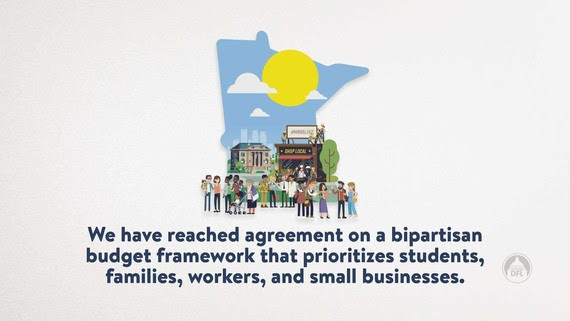Dear Neighbors,
I’m happy to report we are making progress at the Capitol. Yesterday, House DFLers, Senate Republicans, and Governor Walz agreed on a framework for the state budget. The budget deal includes investments in our students and contains the funding to help families and communities thrive that the House majority has been fighting for. After a year of unprecedented challenges, we have the resources to help Minnesotans recover from this pandemic and to invest in a state that works better for everyone. This agreement is a significant step forward.

Our work at the Legislature will continue. We’ve determined how much funding will be dedicated to each section of the budget (E-12 Education, Health and Human Services, and so on), but we still need to decide how the funds will be used. Legislators will negotiate details of the budget over the next few weeks. Conference committees will continue meeting, and I will continue working as part of the State Government and Elections Conference Committee to ensure we are investing in a state government that’s responsive to the needs of Minnesotans. In the next few weeks, there will be opportunities for Minnesotans to weigh in as we continue this work. Please stay tuned for updates.
Upcoming Events and Opportunities to Participate
Rep. Jim Davnie, Sen. Patricia Torres Ray, and I are eager to hear your questions and feedback as we head into the next stage of negotiations with the Senate and Governor to pass a budget. With that in mind, we’re holding a virtual town hall on Thursday, May 27 from 6:00 to 7:30 p.m. If you’d like to join us, you can find more information and RSVP here.

I’m also looking forward to participating in an upcoming discussion of what’s happening in our democracy and what we can do about it. I’ll be interviewing Nancy MacLean, the author of Democracy in Chains, with journalist Don Shelby and MN 350 Executive Director Sam Grant tomorrow at 7:00 p.m. Rep. Rena Moran and Attorney General Keith Ellison will be part of the event as well. If you’d like to join us on Zoom, please register here.
I’m also planning to attend a recap of the legislative session hosted by the 100 Percent Campaign. The event will focus on climate and non-climate related topics that were discussed at the Capitol this year. You can find more information and register for this event here.
Starting the Redistricting Process
Our democracy and government work best when our political maps are fair and reflect the geographical, racial and economic diversity of our state. Every ten years, the U.S. Census provides a count and a picture of Minnesota’s population. Because population changes as people move, die, or are born, every 10 years legislators use U.S. Census data to draw new maps that reflect how our state’s population has changed. This year, we are tasked with the work of redrawing the maps of our eight congressional districts, 67 state senate districts and 134 state house districts.
I’m excited to be a part of this important work as a member of the House Redistricting Committee! At a hearing held on Saturday, we began discussing how to create fair maps that reflect the regional, racial, ethnic, and economic diversity of Minnesota. While we won’t receive the updated Census data we need until late August, we will use the summer to get input from community members across the state of Minnesota. I’ll keep working to ensure we have a robust, fair, and transparent process that centers the voices of Minnesotans in our redistricting efforts.
Please feel free to call or email me if you have questions or feedback. It’s an honor to serve our community.
Sincerely,
Emma Greenman
State Representative